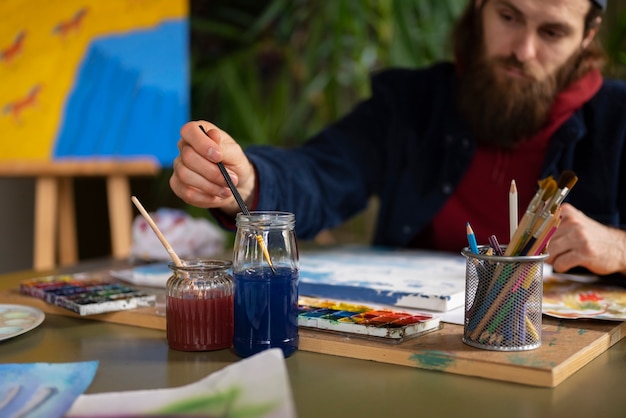Acrylic paints can be applied not only on paper, as we have done with watercolor, legs and canvas on wood. There are special paints, which paint on fabric. What is the difference of the colors of the watercolors? They are not transparent, they can be applied to multiple layers, and paintings are always different brightness and expressiveness.
Acrylic paints are water-soluble, so we will need a jar of water to wash the brush and mix paints to produce different shades.
When the water evaporates, the paint layer becomes hard, it will be impossible to remove; it should be taken into consideration when using acrylic.
Acrylic paints are very flexible tool: it dry quickly and can be applied directly from the tube such as oil with water as a watercolor, and many other intermediate versions. Since acrylic paint dries very quickly, squeeze it out of the tube gradually. If you use an ordinary plastic palette, buy a bottle for to spray water on the paint, and moisturizing it.
PAINTING TECHNIQUE WITH ACRYLIC PAINTS:
Adding to the paint color glossy gel gives shine.
Thin colored layer is obtained by adding opaque gel moreover ink becomes liquid and becomes matte. Semi-gloss finish can be obtained by mixing the two parts of the same gel. Brushes should be kept in a solution of water, as both gel dries quickly and can lead them to be defective.
For painting large areas of uniform, should be used diluents. It gives the paint fluidity and transparency and reduces color fastness. Extend the drying time of the paint you can use a transparent gel (retarder). Retarder should be no more than one part in relation to the two parts of the paint.
When working with the technique of acrylic glaze. Buy and transparency properties of the acrylic watercolor and add a little water. When applying diluted acrylic on white base of the canvas is shown one of its major properties. Acrylic acquires brightness. Given that the acrylic dries quickly coats can be applied almost directly on top of one another.
Sable hair brushes and synthetics brushes are most appropriate for drawing technique glaze.
The gel medium (texture) makes the paint thicker consistency.
In addition to increasing the stability of the paint texture gel for application of thick brush strokes and technique work in impasto. It is represented by four types (clay, a mixture of fibers, resin and natural sand).
It is necessary to paint in thin layers, and only some details to create using a thick relief layer. Referring to brush paintings from different angles, you can get different effects. By experimenting with shapes and sizes of strokes can get different results the relief work.
When using a brush bristle having jagged edges, you can get a pattern resembling an oil painting.
The effect of high similarity with watercolors can be achieved by applying a wet paper several different colors next to and directly connecting them wet brush. For greater safety, you can use the picture paints that have a glossy or matt effect. But it depends on the willingness of the author’s picture.
For tubes of colors provides guidance on the degree of coating ability, light fastness and used pigment.
Basic principles acrylic painting:
So we must always bear in mind that acrylic dries quickly. The painting can be given more depth, brilliance and expressiveness when to paint by layered glazes.
The acrylic painting can be used impasto techniques, like oil. Fortunately it allows excellent coverage and density of undiluted paint.
The main advantages of using acrylic paints
Acrylic paint on the nails dries very quickly – it gives the opportunity to immediately apply the next layer.
You can apply multiple layers – the paint does not crack and does not cleave, it is very flexible.
There is no need to prime the surface before applying acrylic paints pictures on nails.
Acrylic paint is easy to dissolve water that allows you to remove uncured smear conventional flushing.
Due to its resistance to weathering, acrylic paint on nails retain brightness, gloss and are ideal for everyday designs.
In the process of working with acrylic paints no evaporation, preventing breathing.
High elasticity and paint opacity.
Extensive application of acrylic paint on nails: as a watercolor – a thin layer as oil paint – thick, dense layer.
Perform drawings on acrylic nails can learn anyone, even without skill in the art of painting.
Acrylic paints are stored for a long time. Frequently the paint is diluted with water; Acrylic paints can be both universal and specifically designed for use on paper, cardboard, primed and unprimed canvas, various kinds of fabric, wood, leather, glass, and ceramics and so on.



